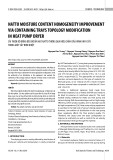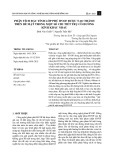
http://www.iaeme.com/IJMET/index.asp 1725 editor@iaeme.com
International Journal of Mechanical Engineering and Technology (IJMET)
Volume 10, Issue 03, March 2019, pp. 1725–1734, Article ID: IJMET_10_03_174
Available online at http://www.iaeme.com/ijmet/issues.asp?JType=IJMET&VType=10&IType=3
ISSN Print: 0976-6340 and ISSN Online: 0976-6359
© IAEME Publication Scopus Indexed
THE WAVE FUNCTION OF MICROPARTICLES
AS A COMPONENT OF SYSTEM RELIABILITY
Nikolay Ivanov Petrov
Institute of Metal Science, Equipment and Technologies with Hydro- and Aerodynamics
Centre ,,Acad. A. Balevski” – Bulgarian Academy of Sciences,
67, Shipchenski prohod St. 1574 Sofia, Bulgaria
ABSTRACT
This article is based on the following scientific proposal, stated by the genius
German physicist Max Planck: “No matter can exist on its own. All matter originates
and exists only by virtue of a force which brings the particle of an atom to vibration and
holds this most minute solar system of the atom together. We must assume behind this
force the existence of a conscious and intelligent mind. This mind is the matrix of all
matter“ [1].
The article discusses the wavelength function of the microcosmos, introduced by
Planck as a component of system reliability and its sustainability. In this aspect, we are
investigating ensuring reliable sustainability at the different levels of the structural and
informational organization of the phenomena in our material world. The statement is
maintained that the unified nature of the reliability of the various phenomena is based
on the unity of the "microcosmos" - its material nature and the capability for duality
and transformations.
Key words: Reliability, microcosmos, sustainability, duality and trans-formations
Cite this Article: Nikolay Ivanov Petrov, The Wave Function of Microparticles as a
Component of System Reliability, International Journal of Mechanical Engineering
and Technology 10(3), 2019, pp. 1725–1734.
http://www.iaeme.com/IJMET/issues.asp?JType=IJMET&VType=10&IType=3
1. INTRODUCTION
The author of this paper proposes a study of the mechanism of the reliability of matter and its
forms at the different levels of its structural organization. The notion of reliability is applicable
in the world of the microcosm, as it reflects the physical nature of elementary particles that we
are investigating. When observing the state of the microparticles (elementary particles),
Planck's constant appears to be the absolute measure of uncertainty. In this sense, it should be
pointed out that the uncertainty principle of Werner Heisenberg states the following:
“Absolutely accurate measurement in the micro and macro world is impossible ! “[2, 3, 4].
Based on the principle of causality in physicochemistry, Max Planck poses the question in
another way: "Are we obliged to seek a constant explanation of the universal unreliability and
inaccuracy, associated with any physicochemical observation? It may be attributed to the

The Wave Function of Microparticles as a Component of System Reliability
http://www.iaeme.com/IJMET/index.asp 1726 editor@iaeme.com
peculiarities of the individual case, to the complexity of the material object under consideration,
or to the imperfection of the measuring instrument, including even our visual organs.
Therefore, the unreliability spreads in two directions - from the individual case to the
general and vice versa, according to the laws of physicochemistry” [Planck M. The Unity of
the physical world’s image. М., 1966] [1].
Max Planck's quantum theory and its basic equation for microparticle (MP) energy, even
written on the memorial plaque, placed on his grave (
E hv
, where
h
is Planck’s constant,
and
v
is the frequency of the physicochemical process) changes our notions in regard to the
function of the error [2]. It testifies for the presence of a tendency for a dialectical "incarnation"
of the error (equivalent to the failure in the physicochemical process) and its opposite – the
reliability.
Typical of this concept is the examination of the error (failure) in the physicochemical
processes as a necessary moment in the "reliable" functioning of the systems. It (the concept)
represents a gnoseological model of the objective reality [6].
2. REGARDING THE WAVELENGTH FUNCTION OF
MICROPARTICLES
The idea of the author of this study is to consider the wave function based on the following
experiment with the light - the most important phenomenon of nature on Earth and in the
Universe. A phenomenon that ensures the existence of humanity and of all forms of a reliable
and real biological world.
Since light possesses corpuscular-wave properties, then the following experiment is
possible. Let a beam of light rays fall on the surface of a transparent plate. According to the
wave notion regarding the nature of these beams, they are reflected from the upper surface of
the plate, and another portion is refracted and passes through it. If the intensity of the falling,
reflected and refracted beam is designated with
,r
II
and
l
I
, the following inequality will be
valid:
rl
I I I
. (1)
The following equation is known
2
IA
, where
A
is the amplitude of the falling wave of
light [3]. As a result of this ratio, the following equation can be recorded:
2 2 2
rl
A A A
, (2)
where
,r
AA
and
l
A
are the amplitudes of the falling, reflected and refracted wave.
If the light is manifested by its corpuscular properties, the intensity of the falling beam of
light will be proportional to the number of photons that are contained therein. If the number of
falling, reflected, and refracted photons is designated with
,r
NN
and
l
N
, then follows that
rl
N N N
. (3)
In order to combine the two concepts regarding the nature of the light (wave and quantum),
the assumption is made that the number of the photons in the beam of light is proportional to
the square of the module of the respective wave. From this assumption, follow the following
formulas for the squares of modules of the reflected and refracted wave [3]:
22
1
rl
AA
. (4)

Nikolay Ivanov Petrov
http://www.iaeme.com/IJMET/index.asp 1727 editor@iaeme.com
2r
r
N
AN
;
2l
l
N
AN
. (5)
The relationship
r
NN
determines what portion of the total number of falling photons is
reflected or the probability that a single photon is being reflected from the surface of the
considered plate. The relationship
l
NN
determines what portion of the total number of falling
photons passes through the surface of the plate, i.e. the probability that a single photon can pass
through the surface of the plate. We do not know which of the falling photons will be reflected,
nor which one will pass through. Their behavior is described by virtue of a probability function,
by using the squares of the amplitudes of their respective waves.
Originating from similar theoretical considerations, the German physician and chemist Max
Planck has suggested that the behavior of each microparticle can be described by single function
, , ,x y z t
, which he named wave function.
The probability of finding the microparticle in a small volume
dV
in the space
W
is
determined by using the wave function in the following way [1, 4]:
2
dW dV
;
2
dW
dV
, (6)
where
is a function, which is a complex conjugate function of
. From (6) follows
that the square of the module of the wave function actually determines the probability density,
i. e. the probability that a particle may be located in a particular unit volume of the space
W
.
Therefore, the physical meaning of Planck's wave function
, , ,x y z t
is probabilistic in
nature. This leads to the conclusion, that is more appropriate for it to be called wave function
of the microparticle reliability (WFMPR). This is so, because the reliability of a given
microparticle is a probability of its presence at a certain time, precisely at the supposed place
in the object (space), in the presence of the respective uncertainty of measurement (even when
observation is performed by using the most exceptional microscope)
Of course, it must be taken into consideration that Max Planck introduces the term wave
function during the time period from 1900 to 1905, when the term “reliability” had not been
formally introduced to science and only the quality of this or that physico-chemical process or
object was discussed.
In order to determine the probability of a given microparticle to be located at a particular
time at any point in the space
W
, then integration of the WFMPR must be performed into the
elementary volume
dV
within the range from
to
, as a result of which follows:
2
, , , . 1W x y z t dV
.
(7)
Since, the probability is a magnitude that varies within the range of 0 to 1, the condition (7)
is called normalization condition of the WFMPR. The physical significance of (7) is related to
the fact that, under certain conditions, the microparticle must surely be located at some point in
the space
W
.
Therefore, the cumulative probability of the particle being located somewhere in the space
shall be equal to one. As a result of this follows that the normalization condition, expressed in
(7) confirms the objective existence of the microparticle in space and time.

The Wave Function of Microparticles as a Component of System Reliability
http://www.iaeme.com/IJMET/index.asp 1728 editor@iaeme.com
From everything that has been analyzed above, follows the conclusion:
“The wave function of the reliability of microparticles combines their wave and quantum
properties and serves in order to describe their behavior in the space of states considered.
Planck's constant appears to be the absolute measure of the uncertainty in measuring the
reliability of microparticles (elementary particles)”.
3. THEOREM REGARDING THE RELIABLE SUSTAINABILITY OF
THE MICROCOSMOS
Already scholars during the antiquity started to discuss the idea of reliability of the
microcosmos. The main idea in Democritus's teachings is : “The being is reality – the atoms,
while non-being is the empty space”.
The study of the probability-stochastic reliability phenomena at the level of the
microparticles and at the atomic levels throughout the entire twentieth century (including the
CERN experiments that have so far given the world only the “World Wide Web” and some
conjectures regarding the existence of the X-boson particle) opens up new opportunities for the
resolution of this problem and ensures the solving of problems the in man-machine systems
[13].
Philosophical form of the theorem: "In order for different systems (obje-cts - atoms,
molecules, chemical compounds, etc.) to be generated and formed from microparticles
(microvesicles), it is necessary to fulfil the following criterion of sustainability: ,, The energy
of the internal connections between the elements of the physicochemical systems must exceed
the sum of the kinetic energy of the microparticles and the energy of the external influences
(continuous or impulse) under the respective conditions of existence”
Mathematically, this is expressed by the inequality:
𝐸𝐶𝐸𝑆 ≥ 𝐸𝐾,Σ + 𝐸𝐸𝐼, (8)
where 𝐸𝐶𝐸𝑆 is energy of the connections between the elements of the system (CES), 𝐸𝐾,Σ -
the cumulative kinetic energy of microparticles, 𝐸𝐸𝐼 - energy of the external influences (EI).
Mathematical form of the theorem - equation for the sustainability of the system of
microparticles (SMP).
We are looking at an ever-evolving system of microparticles (SMP). Its functioning
(interactions) is represented by a system of ordinary differential equations, written in their
generic form:
1 0 0
, ,..., , 1,..., ; ,
i i n i i
x t f t x x i n x t x
(9)
where
t
is an independent variable of the ongoing time;
1,..., n
x t x t
are the functions
sought that determine the basic parameters of the RTS;
0
t
and
0i
x
are the initial set operating
conditions of the system under consideration, and the symbol
ii
x t dx t dt
denotes a
derivates of the function
i
xt
.
In (9) it is presumed that the functions
1
, ,...,
in
f t x x
are real. Under these conditions, it
is possible to record the system of differential equations (9) in the following vector form:
1 0 0
, , ,..., ,
i i n n
x t f t x x colon x x R x t x
(10)

Nikolay Ivanov Petrov
http://www.iaeme.com/IJMET/index.asp 1729 editor@iaeme.com
We can denote with
H
S
a sphere with a radius
H
and center at the beginning of the
coordinates of the Euclidean space
n
R
with norm
2
1
n
i
i
xx
. With
T
is designated an
interval from the real axis of the space, as the following condition is fulfilled
T a t
, where
a
is
or some number. It shall be considered that the function
, , : Hn
f t x f T S R
is continuous with respect to two arguments and fulfills the
conditions of Lipschitz (L) with respect to the second argument, i.e. the following inequality is
valid
, , , 0f t x f t y L x y L const
(11)
Under these conditions, the theorem for local existence is valid, as well as the uniqueness
and continuity of the solution
00
,,x t t x
of the task from (9) regarding the sustainability of
functioning of the SMP under the conditions
0
tT
and
0n
xS
[6].
From the famous axiom of Andrey Lyapunov follows, that the solution
00
,,x t t x
is called
undisturbed (stable) solution, and
xt
- disturbed solution of the system of ordinary
differential equations (9) in the presence of impulse interferences [7, 8, 9, 11].
In some of the earliest scientific papers [3, 5], it is proposed to use impulse differential
equations in order to describe aggregate disturbances on the system of microparticles (SMP).
In the following works [7], it is considered that the investigation of the process of studying of
the functioning of a SMP, which is influenced by aggregate impulse disturbances, is determined
by a simplified version of the system of ordinary differential equations (9), which are expressed
as follows:
00
, ( ) , , , n
x t f t x t x t x x f R
, (12)
and the jumps of the argument 𝑥 of the first order
ix i N
for which are set only their
points in time
i
t
, where
01
... ...
k
t t t
, and the respective estimate of the jumps
ix
, which are caused by the impulse disturbances.
The system of differential equations (12) including taking into consideration the impulse
disturbances, causing jumps ∆𝑖𝑥, is recorded as follows:
𝑑𝑥(𝑡)𝑑𝑡
⁄= 𝑓(𝑡, 𝑥(𝑡))+∑ (∆𝑖𝑥)
+∞
𝑖=1 𝛿Д(𝑡 − 𝑡𝑖) (13)
where 𝛿Д is the delta function of Dirac during the time interval (𝑡 − 𝑡𝑖).
A natural transformation is performed, by replacing the second member on the right side of
(13) with the function
gt
, where 𝑔(𝑡): [0, +∞) → 𝑅𝑛 is a defined continuous left-hand
function, locally limited by variation. The function
gt
is assumed to be an impulse
disturbance of the equations (12). The result is a new look of the system of differential equations
(13):
𝑑𝑥(𝑡)𝑑𝑡
⁄= 𝑓(𝑡, 𝑥(𝑡)) +
gt
, (14)














![Bài tập tối ưu trong gia công cắt gọt [kèm lời giải chi tiết]](https://cdn.tailieu.vn/images/document/thumbnail/2025/20251129/dinhd8055/135x160/26351764558606.jpg)











